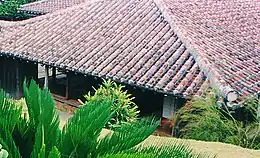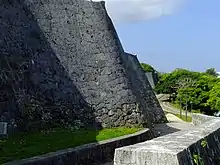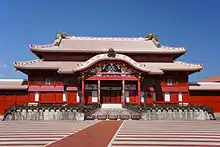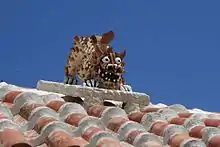Okinawan architecture
The history of Okinawan architecture dates back to the Shell Mound Period that lasted between 2000–1000 BC. During this period, houses in Okinawa were principally pit dwellings. Constructors dug houses into the red earth or encircled them by walls made of limestone material. Hearths never featured in either of the two forms of pit-dwellings. During the late quarter of the Shell Mound Period, people started building structures that pillars supported. To build the new buildings, people started using the black muddy soil found in the area to produce tiles.[1] The first step involved mixing the mud with water and drying it for forty days. The second step involved baking the tiles and this led to the roof tiles will has the red color, which is the most significant feature of Okinawan architecture. The red roofs were a preserve of aristocrats because commoners used to live in grass-thatched houses. In 1889, however, the Shuri government abolished the exclusive use of red tiles among the aristocrats and commoners started using the design on their houses. Since then, red tiles are a common feature on houses in Okinawa.

In addition to the houses with red roofs, Okinawan architecture also consists of castles or fortresses, which are prominent in the Ryukyu Islands. The primary feature of these structures is their stone walls. The structures, commonly referred to as gusuku, also have one or multiple baileys, depending on their size. An additional feature is the presence of gates guarding entrances. At the heart of these buildings is a main hall, often referred to as seidan, which is reserved as the residence of the feudal lord. Moreover, almost all the gusuku structures contain shrines that occupants use to perform religious rites. The Shuri Castle is an example of a gusuku structure.
Appearance

The extensive use of stonework characterizes Okinawan architecture. It is similar with Japan’s stacking style, but it is different in the use of white limestone. Accordingly, Okinawan houses are different from the houses found in mainland Japan in terms of aesthetics rather than style.[2] In fact, Okinawan houses are made of three different styles of stonework: aikata-zumi, nozura-zumi, and nuno-zumi.[3] Aikata-zumi involves curving of stones in a uniform manner to make shapes such pentagons and hexagons.[4] The uniformity of the stones makes it possible to remove one stone and the rest to hold up without weakening the structure. Nozura-zumi involves stacking stones of different sizes and shapes to form a wall without paying attention to aesthetics.[5] It was the first type of stonework among the three. Finally, nuno-zumi involves cutting stones into rectangular shapes and stacking them together to form a wall. Even though it produces beautiful appealing walls, the disadvantage is that removing one stone can result in the collapse of the remaining stones. For that reason, the appearance depends on the choice of one of three types of stonework, which can be either aesthetically appealing or unattractive, but all are made of white limestone.
In addition to the external appearance, the internal sections of Okinawan homes are also made of black stone walls. These stones are commonly referred to as himpun and their role is to protect the homes from unwanted spirits. Moreover, the walls separate different sections of the houses and ensure that there is order whenever people are in the homes. Overall, Okinawan architecture led to the construction of appealing structures, especially the red roofs. In most cases, it is the open layout of the structures and the unique roof color and design that makes these houses attractive.
Functions
Buildings in Okinawa served multiple functions including protecting occupants and hosting people. Primarily, walls made of white limestone surround the Okinawan homes, which serves the purpose of ensuring the privacy of the occupants. Sections of the wall remain open to ensure easy access and allow passage of breeze. Even so, the entrance opening is not wide open but is blocked by a wall section commonly referred to as hinpun, which serves the function of protecting occupants from evil spirits.[6] Notably, most of the houses have lion-dogs made of ceramic on top of the roof or the gate to protect occupants from evil spirits.
In addition to protection, Okinawan homes consist of numerous rooms that accommodate people. A typical house consists of between four and five rooms plus a kitchen. There are two rooms located at the front that serve to entertain visitors. These rooms are commonly referred to as ichibanza and nibanza to represent the first and second rooms respectively.[7] Behind the two rooms are two or three rooms that the family uses as private spaces and bedrooms. In some cases, Okinawan homes consist of an additional structure that serves the purpose of accommodating the aged, such as the retired former head of the house or mother to the head of the house.
Beyond protection and hosting people, buildings in Okinawa served the function of reflecting the experiences and cultures of the local people, which can be passed from one generation to another. Even though architecture creates, there is the influence of the surrounding environment including people’s culture, geography and climate. Okinawa is a beautiful location and its architecture reflects its history and fascinating interaction with surrounding regions. For instance, Shuri Castle is blend of Chinese and Japanese architecture. The structure fits the region’s climate while also preserving the history between Japan and China.[8] Another example is the Nakamura Family Residence, which is a reflection of the cultural traditions of both Chinese and Japanese people. To demonstrate the function of protection, the house has a strategic stone entry that protects the building from evil spirits. Also, there is a traditional shisa lion sitting on the red tile roof of the building to signal protection from unwanted spirits. The red tile roof was a common feature of the Okinawan architecture and it demonstrated the ability of the local people to build structures that could withstand regular typhoons and show the region’s years of adaptation and traditions.[9] Here, the function of Okinawan architecture is to store and convey important stories about the lives and experiences of the people of Okinawa. It demonstrates that the houses were more than structures that could be used for protection and accommodation. Therefore, Shuri Castle and the Nakamura Family Residence represent the function of Okinawan architecture structures as custodians of traditional culture, history and people’s adaptation to climate conditions.
Maintenance
Okinawa Island is the windiest part of Japan, which makes it easy for the tiles to fall off, which require constant repairs. For the most part, the residents of the area prefer abandoning the homes for new grounds where they start building new homes.[10] Some residents, however, prefer to repair their houses. There are masons who specialize in repairing homes wrecked by either strong winds or a typhoon at a fee. Others are knowledgeable and can repair their homes without the assistance of professionals. Notably, the regular typhoons in the region are the main reason for the change in designs of the architecture. For instance, wood was a preference in previous generations because of its ability to allow fresh air to circulate within a building. However, now, the maintenance of buildings involves the use of concrete for protection purposes. In addition, the Japanese have recently changed the design of the windows to act as a protection against debris from typhoons. Most notably, they use barred windows. In this case, most new constructions and maintenance of old buildings involve considerations for changing environmental conditions. For instance, while the roofing of traditional Japanese homes involved the layering of tiles, it now encompasses cementing of tiles, so that strong winds do not blow them away.

Reconstruction is also a common element of maintenance in Okinawan architecture, especially for famous buildings with cultural value. The Shuri Castle is a famous Okinawan architecture building that has been reconstructed numerous times after being ruined during war and conflict. The building experienced significant ruin during the Battle of Okinawa, which lasted from March to June in 1945, because it was used by the Japanese army as a bunker.[11][12] Over the period of the conflict, only little remains of the castle were left by the end of the conflict. Only the land surface and castle’s underground foundations remained. The Japanese government later designated the remains of the site as a historical site. Between 1989 and 1992, however, the Ministry of Construction and the Okinawa Development Agency started reconstructing the castle.[13][14] During the reconstruction period, historians and engineers played the critical role of restoring the castle to its past form. They gathered photos and images from historical records, which were used to design the new castle to match its past form. Up to date, the castle is regularly maintained through reconstruction of missing rooms and structures that were recognizable in the past. Therefore, the reconstruction of the Shuri castle demonstrates the extent to which the people of Okinawa value maintenance of their buildings and approach it as an ongoing process.
Example of Okinawan building

Arguably, Shuri Castle is the most famous building in the history of the Okinawan architecture because of its cultural heritage and persistence since the late 1300s. Perched on a hilltop, Shuri Castle is a diplomatic, cultural and political symbol in Okinawa because it served as Kingdom’s headquarter for more than 400 years.[15] As such, the castle is the best place from where visitors to Okinawa can start to learn about the unique culture of the place. A first look at the façade provides visitors with a first look at Okinawa’s culture, which is distinct from the rest of Japan. The unique aspect of the building is its hybrid architecture that blends ideas from Japan, China and Southeast Asia. In fact, the blending of the different architectural ideas originates from the extensive trade that took place in Okinawa.[16] For instance, the castle’s main hall is decorated with embellishments and carvings such dragon figures, which were borrowed from China. Moreover, the main hall is painted in bright gold color, which is evidence of the golden age of culture and commerce that took place in Okinawa when it was part of the Ryukyu kingdom.
The people of Okinawa identify with the Shuri Castle because it communicates their rich intangible cultural heritage. The reconstruction of the castle is one point in case. Historically, the Shuri Castle has been destroyed multiple times. In fact, its destruction during the Battle of Okinawa was the most devastating in its history because it led to complete destruction. No structure was spared and only the space that it once occupied remained by the end of the conflict. Because of its cultural value, however, the government and the local community worked together to reconstruct the structure to its original form and it was reopened to the public in 1992.[17][18] Since its opening, the building has been conserved as a cultural heritage that the local people enjoy along with visitors who visit the area as tourists. At the moment, the people of Okinawa associate the structure with their experiences. For instance, the reconstruction of the castle presented the local people with the opportunity to reflect on their past values and narrate afresh their experiences for future generations. Restoring the building to its past form demonstrates the interest of the local people of Okinawa to preserve their heritage.[19] Opening the castle to the public and tourists demonstrates their interest to share their heritage with the rest of the world. As such, the Shuri castle is a symbol of cultural heritage in Okinawa, which explains its fame.
References
- "Okinawa: Architecture of History and Tradition - Journeys in Japan". Japan Documentaries. Retrieved March 31, 2019.
- Baker, Rodger. "1945: Asia's Powers Converge at Okinawa". Retrieved 2015. Check date values in:
|accessdate=(help) - Heinrich, Patrick; Miyara, Shinsho; Shimoji, Michinori (2015-02-17). Handbook of the Ryukyuan languages: History, structure, and use. ISBN 9781614511151. Retrieved 2015. Check date values in:
|accessdate=(help) - litaka, shingo. "Remembering Nan'yō from Okinawa: Deconstructing the Former Empire of Japan through Memorial Practices". Retrieved 2015. Check date values in:
|accessdate=(help) - Youngest, Baik (2015). "Implications of Chinese empire discourses in East Asia: critical studies on China". Inter-Asia Cultural Studies. 16 (2): 206–226. doi:10.1080/14649373.2015.1037074.
- Boyd, Dixon. "Okinawa as Transported Landscape: Understanding Japanese Archaeological Remains on Tinian Using Ryūkyū Ethnohistory and Ethnography". Retrieved 2015. Check date values in:
|accessdate=(help) - Iitaka, Shingo. "Remembering Nan'yō from Okinawa: Deconstructing the Former Empire of Japan through Memorial Practices". Retrieved 2015. Check date values in:
|accessdate=(help) - Takamiya, Hiroto. "An extraordinary case in human history: Prehistoric hunter-gatherer adaptation to the islands of the Central Ryukyus". doi:10.1177/0959683615609752. Cite journal requires
|journal=(help) - Matthew, Allen. "The shaman hunts and the postwar revival and reinvention of Okinawan shamanism". Retrieved 2016. Check date values in:
|accessdate=(help) - Kiyoko, Hagihara; Chisato, Asahi. "Coping with regional vulnerability". Retrieved 2016. Check date values in:
|accessdate=(help) - Shimoda, Hiraku. "Heritage Politics: Shuri Castle and Okinawa's Incorporation into Modern Japan, 1879–2000". Retrieved 1 June 2015.
- Koikari, Mire. "Rethinking Okinawa and Okinawan Studies: Three Perspectives". Retrieved 2017. Check date values in:
|accessdate=(help) - Timothy, Dallen J. "Tourism and Trails Cultural, Ecological and Management Issues". Retrieved 5 December 2014.
- Johnson, Kendall. "The New Middle Kingdom China and the Early American Romance of Free Trade". Retrieved 2017. Check date values in:
|accessdate=(help) - Tredinnick, Jeremy. "Cultural Paradise". Retrieved 2019. Check date values in:
|accessdate=(help) - Final, Gerald (2013). "Beachheads: War, peace, and tourism in postwar Okinawa". Journal of Tourism History. 5 (3): 346–347. doi:10.1080/1755182X.2014.913371.
- Sung, Meesook (2017). "Investigation and analysis of Ryukyu lacquerwares decorated with wisteria vine by pyrolysis GC/MS and 87Sr/86Sr isotope ratio". Surface and Interface Analysis. 49 (9): 822–827. doi:10.1002/sia.6228.
- Antunes and Polónia, Cátia and Amélia. "Beyond Empires: Global, Self-Organizing, Cross-Imperial Networks, 1500-1800". Retrieved 24 June 2016.
- Arne, Røkkum (2015). "In the Image of the Other: Nineteenth-Century British Voyagers and Okinawans at the Point of Meeting". History and Anthropology. 26 (5): 553–575. doi:10.1080/02757206.2015.1086998.
